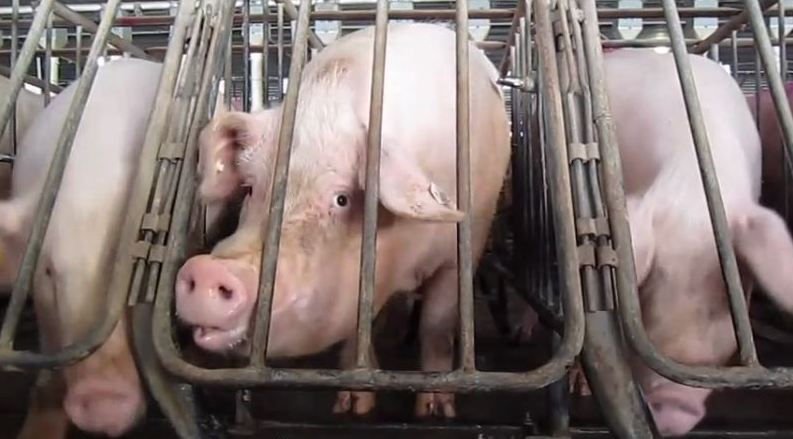Submitted by Dru Oja Jay on

The following is a translation of an article that appeared in La Jornada
by Silvia Ribeiro
The COVID pandemic has caused the many veils concealing the perverse workings of the global capitalist system to be lifted. One of the veils that has been torn apart, exposing a stinking reality, is the role of the agro-industrial food system, which has been the main factor in the creation of epidemics in recent decades.
The industrial breeding of animals in confinement, including poultry, pigs and cattle, has created a veritable factory of animal and human epidemics. According to the WHO, large concentrations of genetically uniform animals with weakened immune systems, in overcrowded conditions and to which antibiotics are continuously administered, are the main cause of antibiotic resistance.
Such conditions also constitute a perfect breeding ground to produce mutations of even more lethal viruses and multi-resistant bacteria. Under a global system of free trade agreements, these viruses and bacteria then spread throughout the world.
Biologist Rob Wallace, author of the book Big Farms Make Big Flu, documents this process by analyzing outbreaks of new animal viruses, such as the avian and swine flus, Ebola, Zika, HIV and others. Many of them originated in hatcheries, while others came from wild animals, such as the bat-derived coronavirus COVID19.
Recent studies indicate that these viruses and bacteria did not reach humans directly; information derived from genomic sequencing reveals that they spread through animal intermediaries like pangolins and small Asian mammals before reaching human populations.
There could also have been other intermediaries, for instance, mega pig farms in Hubei province, of which Wuhan, where the COVID pandemic began, is the capital. The organization GRAIN has compiled useful data on this phenomenon (https://tinyurl.com/ybdvmegz).
At the same time that COVID19 was detected, large pig farms in China were also being devastated by another virus that kills millions of pigs: African Swine Fever which fortunately has not yet mutated into an infectious virus in humans, but is still growing in China and Europe (https://tinyurl.com/y9f98atd).
The relationship between industrial animal husbandry and epidemics/pandemics goes beyond large farms. As I explain in another article (Desinformémonos, https://tinyurl.com/ydenks9z), there are concomitant causes: the massive breeding of animals converges with the destruction of natural habitats and biodiversity, which otherwise function as barriers to contain the spread of viruses in wild animal populations.
The main culprits in the destruction of ecosystems are the agro-industrial food system as well as uncontrolled urban growth and the accompanying advance of mega-projects such as mining, roads and commercial corridors, like the Transisthmian Corridor.
The agro-industrial food system plays a central role: according to the FAO, the main cause of deforestation in the world is the expansion of the industrial agricultural frontier. The frontier is responsible for up to 80 per cent of deforestation in Brazil and 70 per cent in Latin America as a whole.
Of all the agricultural land on the planet, 78 percent is used for the large-scale livestock industry - either for grazing or planting fodder. More than 60 percent of the cereals that are grown globally are used to feed animals in confinement. (ETC Group, https://tinyurl.com/y7lszo4n)
At each step of the agro-industrial food chain, 4 to 5 large transnationals dominate more than 50 percent of the global market. (See Plate Tech-Tonics, map of corporate power in the food chain, ETC Group, 2020 Link to the English version here)
For example, only three companies (Tyson, EW group and Hendrix) control all poultry genetics sales on the planet. Another three control half of all swine genetics, and just a few more control bovine genetics. This causes an enormous genetic uniformity on the farms, facilitating the transmission and mutation of viruses.
The same is true of the companies involved in the global trade in agricultural commodities (grains and oilseeds), controlled almost entirely by six companies: Cargill, Cofco, ADM, Bunge, Wilmar International and Louis Dreyfus Co. These companies trade the fodder for industrial animal husbandry, mainly transgenic soybeans and maize.
The largest processors of poultry, pork and beef are currently JBS, Tyson Foods, Cargill, WH Group-Smithfield and NH Foods. In North America, China's WH Group is the world's largest pork company and owns Carroll Farms, where the swine flu originated.
The example of Cargill is significant; as the largest global trading company of agricultural commodities, it went from providing fodder, to breeding animals, becoming the third largest meat company globally (breeding meat from poultry, pig and cows).
Despite the disasters caused by the Covid-19 pandemic, these companies are still in business, managing the next pandemic, which could occur while the current one is still active.
It is time to put an end to this absurd and harmful agri-food system, which only benefits corporations. (here link to WWFU in English)
It is this system which is the main factor in climate change. Yet, despite using 70 to 80 percent of the world's land, water and fuel for agriculture use, it feeds only 30 percent of the world's population.
English
